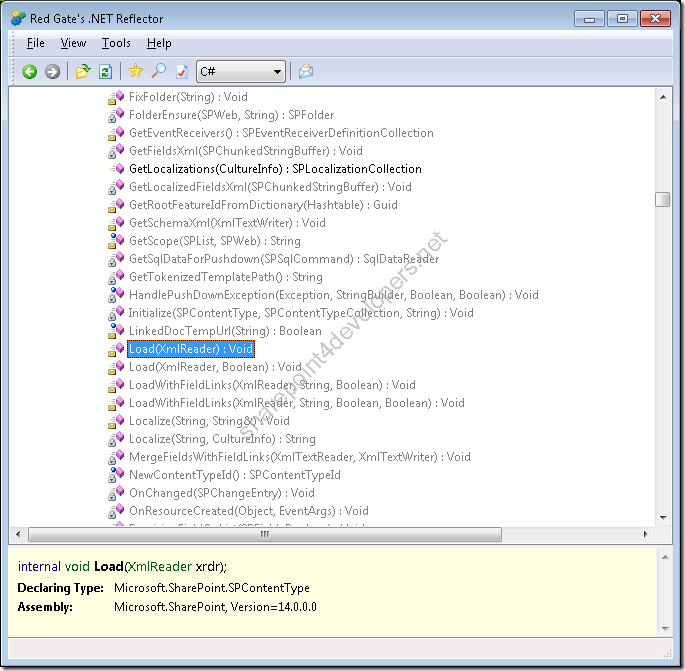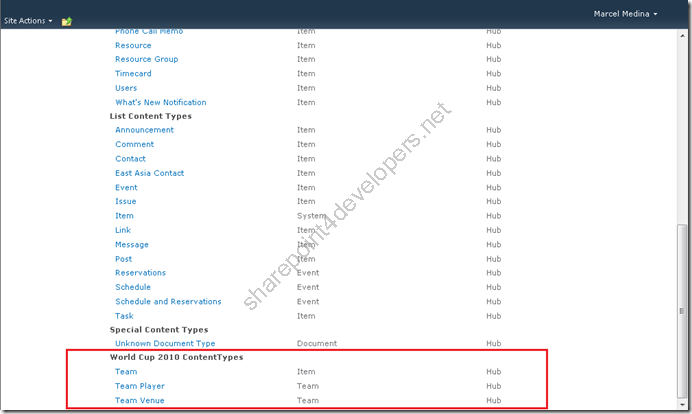Oi pessoal,
Segue aqui mais uma nota rápida, agora para a criação de content types via XML. Esse tipo de abordagem não é comum, pois exige Reflection para a utilização de métodos de escopo Internal da classe SPContentType do namespace Microsoft.SharePoint.
Podemos criar Content Types utilizando XML se criarmos uma Feature para tal, porém se você possui o XML e não quer utilizar uma Feature, a única saída é utilizar Reflection como solução.
Considere o seguinte XML:
Code Snippet
- <Elements xmlns="http://schemas.microsoft.com/sharepoint/">
- <ContentType ID="0x0100BEBD79039D12B646B28237616422B927"
- Name="Team"
- Group="World Cup 2010 ContentTypes"
- Version="1">
- <Folder TargetName="_cts/Team" />
- <XmlDocuments>
- <XmlDocument NamespaceURI="http://schemas.microsoft.com/sharepoint/v3/contenttype/forms">
- <FormTemplates xmlns="http://schemas.microsoft.com/sharepoint/v3/contenttype/forms">
- <Display>ListForm</Display>
- <Edit>ListForm</Edit>
- <New>ListForm</New>
- </FormTemplates>
- </XmlDocument>
- </XmlDocuments>
- <FieldRefs>
- <FieldRef ID="{fa564e0f-0c70-4ab9-b863-0177e6ddd247}" Name="Title" Required="TRUE" />
- <FieldRef ID="{05a571ad-f9d1-4aab-a703-1af3ae393fbf}" Name="Country" Required="TRUE" />
- </FieldRefs>
- </ContentType>
- <ContentType ID="0x0100BEBD79039D12B646B28237616422B92701"
- Name="Team Player"
- Group="World Cup 2010 ContentTypes"
- Version="1">
- <Folder TargetName="_cts/Team Player" />
- <XmlDocuments>
- <XmlDocument NamespaceURI="http://schemas.microsoft.com/sharepoint/v3/contenttype/forms">
- <FormTemplates xmlns="http://schemas.microsoft.com/sharepoint/v3/contenttype/forms">
- <Display>ListForm</Display>
- <Edit>ListForm</Edit>
- <New>ListForm</New>
- </FormTemplates>
- </XmlDocument>
- </XmlDocuments>
- <FieldRefs>
- <FieldRef ID="{fa564e0f-0c70-4ab9-b863-0177e6ddd247}" Name="Title" Required="TRUE" />
- <FieldRef ID="{05a571ad-f9d1-4aab-a703-1af3ae393fbf}" Name="Country" Required="TRUE" />
- <FieldRef ID="{04555083-ec04-4c20-a609-42a283428374}" Name="PlayerName" Required="TRUE" />
- <FieldRef ID="{2f2abeb9-ed3d-41d9-bbde-03d1150396a1}" Name="PlayerAge" Required="FALSE" />
- <FieldRef ID="{ea4b814a-a18b-403a-a33a-8ea5436cb540}" Name="Position" Required="TRUE" />
- </FieldRefs>
- </ContentType>
- <ContentType ID="0x0100BEBD79039D12B646B28237616422B92702"
- Name="Team Venue"
- Group="World Cup 2010 ContentTypes"
- Version="1">
- <Folder TargetName="_cts/Team Venue" />
- <XmlDocuments>
- <XmlDocument NamespaceURI="http://schemas.microsoft.com/sharepoint/v3/contenttype/forms">
- <FormTemplates xmlns="http://schemas.microsoft.com/sharepoint/v3/contenttype/forms">
- <Display>ListForm</Display>
- <Edit>ListForm</Edit>
- <New>ListForm</New>
- </FormTemplates>
- </XmlDocument>
- </XmlDocuments>
- <FieldRefs>
- <FieldRef ID="{fa564e0f-0c70-4ab9-b863-0177e6ddd247}" Name="Title" Required="TRUE" />
- <FieldRef ID="{05a571ad-f9d1-4aab-a703-1af3ae393fbf}" Name="Country" Required="TRUE" />
- <FieldRef ID="{af008077-3a7e-41d9-aaca-2b0997bb5e25}" Name="HostCity" Required="TRUE" />
- <FieldRef ID="{9910fa0d-c7e8-464a-9607-caba1502b7dc}" Name="Arrival" Required="FALSE" />
- </FieldRefs>
- </ContentType>
- </ Elements >
Para adicionar os Content Types acima podemos utilizar o seguinte trecho de código:
Code Snippet
- using System;
- using System.Collections.Generic;
- using System.Linq;
- using System.Text;
- using System.Xml;
- using System.IO;
- using Microsoft.SharePoint;
- using CommonLibrary;
-
- namespace ContentTypes
- {
- class Program
- {
- static void Main(string[] args)
- {
- using (SPSite site = new SPSite("http://localhost"))
- {
- using (SPWeb web = site.RootWeb)
- {
- XmlDocument xmlDoc = new XmlDocument();
-
- xmlDoc.Load(Path.GetFullPath("ContentTypes.xml"));
-
- foreach (XmlElement fieldNode in xmlDoc.DocumentElement.ChildNodes)
- {
- SPContentType ct = ContentTypesHelper.CreateEmptyContentType();
-
- XmlTextReader xmlReader = new XmlTextReader(fieldNode.OuterXml, XmlNodeType.Element, new XmlParserContext(xmlDoc.NameTable, null, "en", XmlSpace.Default));
-
- ContentTypesHelper.LoadContentTypeFromXml(ct, xmlReader);
-
- ContentTypesHelper.SetContentTypeScope(ct, web);
-
- site.RootWeb.ContentTypes.Add(ct);
-
- site.RootWeb.Update();
- }
- }
- }
- }
- }
- }
Analisando o código acima, podemos perceber que os métodos CreateEmptyContentType, LoadContentTypeFromXml e SetContentTypeScope são responsáveis pela criação dos Content Types e estão contidos na classe utilitária ContentTypesHelper. Esses métodos utilizam Reflection e foram criados por Robert Fridén em seu blog há anos atrás e resolvi reutilizá-los.
Se analisarmos a classe Microsoft.SharePoint.SPContentType pelo .NET Reflector conseguiremos ver seus métodos de escopo Internal, conforme Figura abaixo:

Figura 1 - Classe SPContentType visualizada pelo .NET Reflector
Vejamos então o código da classe utilitária ContentTypesHelper:
Code Snippet
- using System;
- using System.Collections.Generic;
- using System.Linq;
- using System.Text;
- using System.Reflection;
- using System.Xml;
- using Microsoft.SharePoint;
-
- namespace CommonLibrary
- {
- public class ContentTypesHelper
- {
- /// <summary>
- /// Creates an Empty Content Type
- /// </summary>
- public static SPContentType CreateEmptyContentType()
- {
- ConstructorInfo constructor = (typeof(SPContentType)).GetConstructor(
- BindingFlags.NonPublic | BindingFlags.Instance,
- null,
- Type.EmptyTypes,
- null);
-
- SPContentType ctype = (SPContentType)constructor.Invoke(new object[0]);
-
- return ctype;
- }
-
- /// <summary>
- /// Loads Content Type from XML
- /// </summary>
- public static void LoadContentTypeFromXml(SPContentType ctype, XmlTextReader xmlReader)
- {
- MethodInfo loadMethod = ctype.GetType().GetMethod("Load",
- BindingFlags.NonPublic | BindingFlags.Instance,
- null,
- new Type[] { typeof(XmlReader) },
- null);
-
- loadMethod.Invoke(ctype, new object[] { xmlReader });
- }
-
- /// <summary>
- /// Sets Content Type from XML
- /// </summary>
- public static void SetContentTypeScope(SPContentType ctype, SPWeb web)
- {
- string scope = web.ServerRelativeUrl.TrimStart('/');
-
- MethodInfo setCTScopeMethod = ctype.GetType().GetMethod(
- "SetScope",
- BindingFlags.NonPublic | BindingFlags.Instance,
- null,
- new Type[] { typeof(string) },
- null);
-
- setCTScopeMethod.Invoke(ctype, new object[] { scope });
-
- PropertyInfo fieldLinksScopeProperty = ctype.FieldLinks.GetType().GetProperty(
- "Scope",
- BindingFlags.NonPublic | BindingFlags.Instance,
- null,
- typeof(string),
- Type.EmptyTypes,
- null);
-
- fieldLinksScopeProperty.SetValue(ctype.FieldLinks, scope, new object[0]);
-
- PropertyInfo contentTypeWebProperty = ctype.GetType().GetProperty(
- "Web",
- BindingFlags.NonPublic | BindingFlags.Instance,
- null,
- typeof(SPWeb),
- Type.EmptyTypes,
- null);
-
- contentTypeWebProperty.SetValue(ctype, web, new object[0]);
- }
- }
- }
No final os Content Types serão criados conforme a Figura abaixo:

Figura 2 – Criação dos Content Types
Baixe a solução aqui.
Considerações
-
Os Site Columns não são herdados automaticamente ao utilizarmos essa abordagem. Observem que os Content Types do XML estão listando todas as colunas, o que não seria necessário se a herança funcionasse corretamente.
-
A adição da propriedade Inherits=TRUE não modifica esse comportamento.
Referências:
http://msdn.microsoft.com/en-us/library/system.reflection.bindingflags.aspx
http://www.15seconds.com/issue/050602.htm
http://vspug.com/bobsbonanza/2007/12/17/deploying-site-columns-and-content-types-to-sharepoint-webs
http://www.red-gate.com/products/reflector
[]’s
Marcel Medina


Clique aqui para ler o mesmo conteúdo em Inglês.